You lost half your Google traffic.
But suddenly…more people are searching for your brand. What’s going on?
Welcome to the invisible influence of LLMs, where your visibility goes up even when traffic goes down.
New research from Semrush reveals a seismic shift happening right now: LLM traffic will completely overtake traditional Google search by 2027.

There’s A LOT to think through here.
The good news?
If you’re already doing quality SEO, you’re 70% of the way there. The next step is to ensure your expertise is recognized by AI systems.
In this guide, you’ll learn:
- Why Google rankings are no longer your best growth signal
- What LLM visibility actually means
- How to track and influence this new layer of search that’s driving brand discovery
Let’s start with what your current analytics are struggling to see.
Your Brand Is Blowing Up in LLMs (You Just Can’t See It)
LLMs are quietly becoming the biggest brand discovery platform on the internet.
Users ask AI about your industry, see your brand mentioned, and then visit you directly later.
The problem is you can’t see this influence in Google Analytics.
What Your Analytics Miss
Almost 90% of ChatGPT’s citations come from search results ranking in positions 21+ — not the top 5 rankings you’re fighting for.
While you optimize for position #1, ChatGPT mines pages 3, 5, and 10 for answers. And users trust those recommendations.

This data focuses on ChatGPT, but similar patterns appear across LLMs.
Gemini also favors long-tail sources, and Perplexity shows comparable citation behaviors across the ecosystem.
Looking forward: Google’s massive reach through AI Overviews and the AI Mode rollout positions them as the long-term leader, even as ChatGPT dominates current conversations.
How Discovery Has Changed
Discovery is fundamentally changing:
Old way: Google → Click → Explore → Decide
New way: Ask AI → See mention → Visit directly later
And different generations use LLMs differently.
- College students treat ChatGPT as an “operating system.”
- Users in their 20s-30s use it as a “life advisor.”
- Older users see it as a Google replacement.
Still, each interaction creates invisible brand impressions.
When someone discovers you through an LLM and visits later, it appears as:
- Direct traffic (typed your URL)
- Branded search (Googled your name)
- Untagged referral (bookmarked and returned)
There’s zero attribution to the LLM mention.
So you have to get creative.
4 Signs Your LLM Visibility Is Growing
Your analytics might be telling a story of decline, while your brand influence is actually exploding.
This exact pattern is happening to Backlinko.
Our clicks dropped 15% while impressions surged 54% over the past three months.
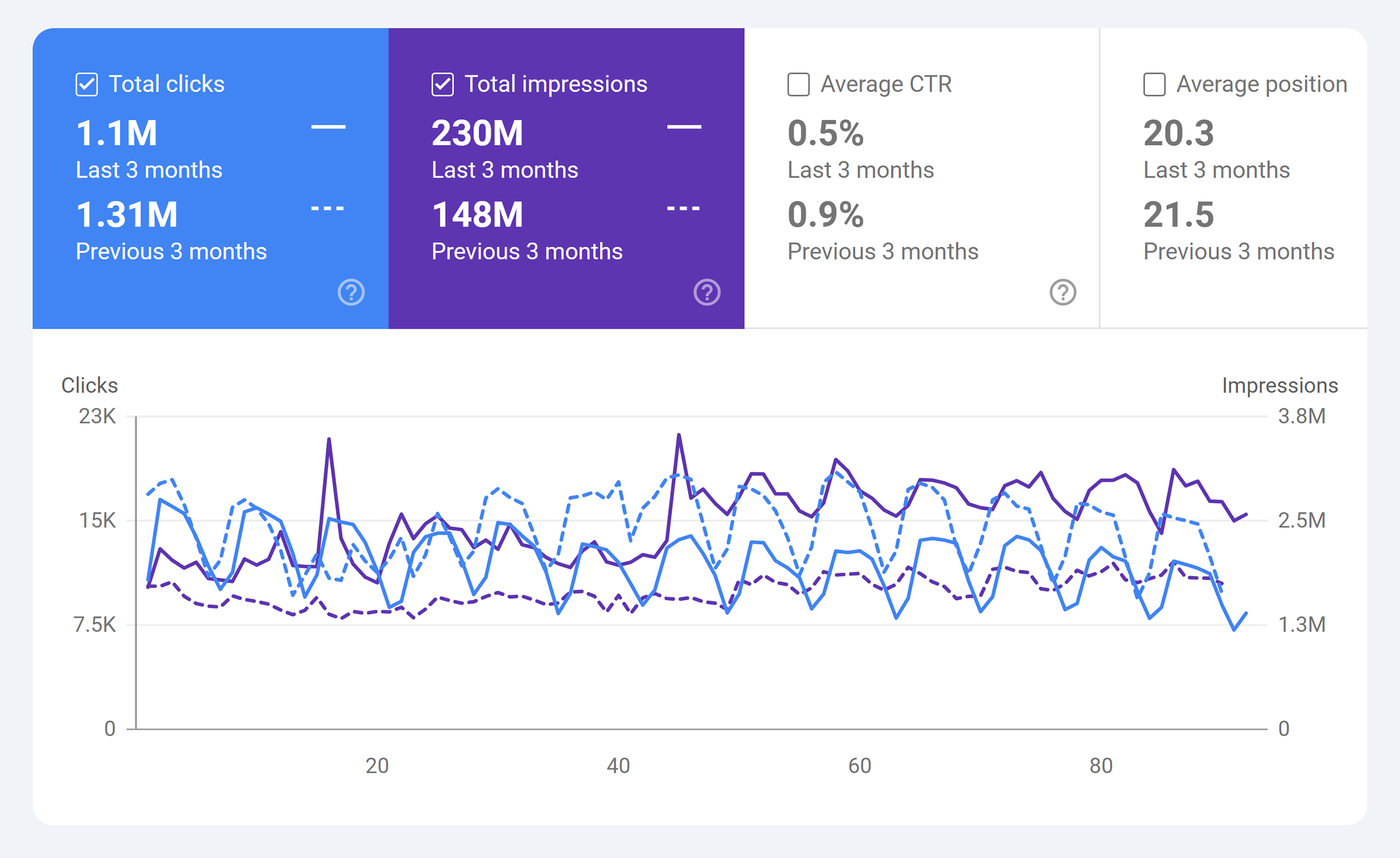
More people are seeing our content in search results, but fewer are clicking through.
They’re likely discovering us through AI responses, then searching for us directly later.
Here are four signs that LLM visibility might be driving invisible growth for your brand:
- Declining organic traffic + stable branded searches: People are discovering you elsewhere first, then searching for your brand directly.
- Sales calls mentioning “found you through AI”: Direct evidence of LLM-driven discovery that never shows up in analytics.
- Direct traffic holding steady despite fewer Google clicks: Users are bypassing search entirely after AI discovery.
- Competitors gaining share with weaker traditional SEO: They’re likely winning LLM visibility while you focus on rankings. (More on what that looks like later.)
How LLMs Find and Cite Content
Historically, SEO has been fairly straightforward. For the most part, it’s predictable cause and effect.
Optimize for keyword X, build Y backlinks, get position Z.
LLM visibility operates differently. It’s probabilistic and contextual.
This emerging discipline is Generative Engine Optimization (GEO). It’s the practice of optimizing for AI-powered search systems.
While this guide focuses on measuring LLM visibility specifically, it’s part of the broader GEO strategy.
With that said, think of GEO as an extension of SEO rather than replacing it, as many of the skills overlap.
The fundamental difference:
- SEO: Deterministic rankings drive traffic
- GEO: Probabilistic mentions build influence
Why Rankings Don’t Predict LLM Citations
Different LLMs prioritize different authority signals, creating multiple opportunities for visibility.
For example, when you search “best SEO blogs in 2025,” Google’s AI Overview cites established brands.
It mentions Backlinko alongside Search Engine Land, Semrush, and other recognized industry leaders.
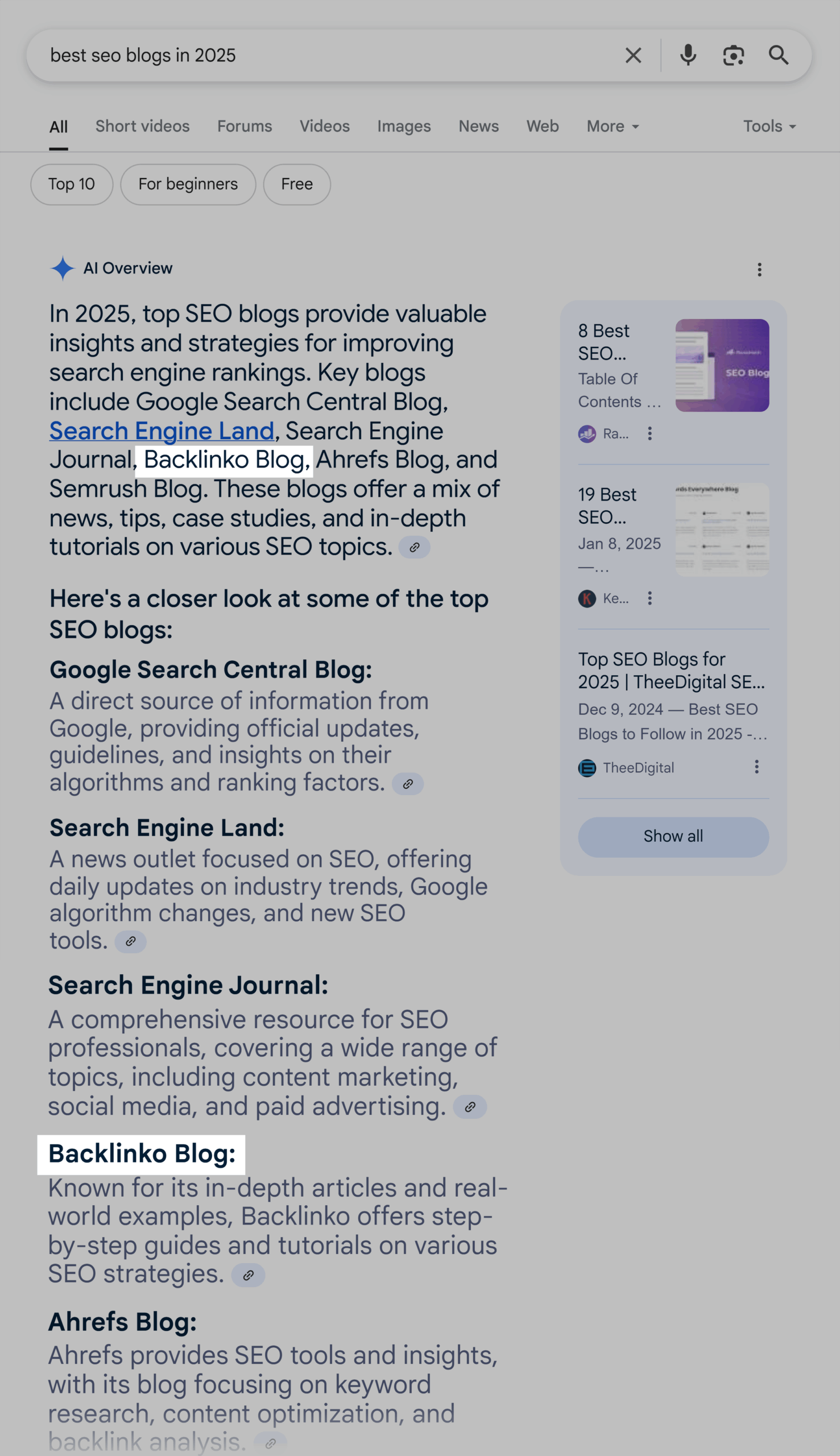
Open the top three cited posts in the AIO, and they all mention the same blogs.
Ask ChatGPT the same question (logged out in a private browser), you get a similar list.
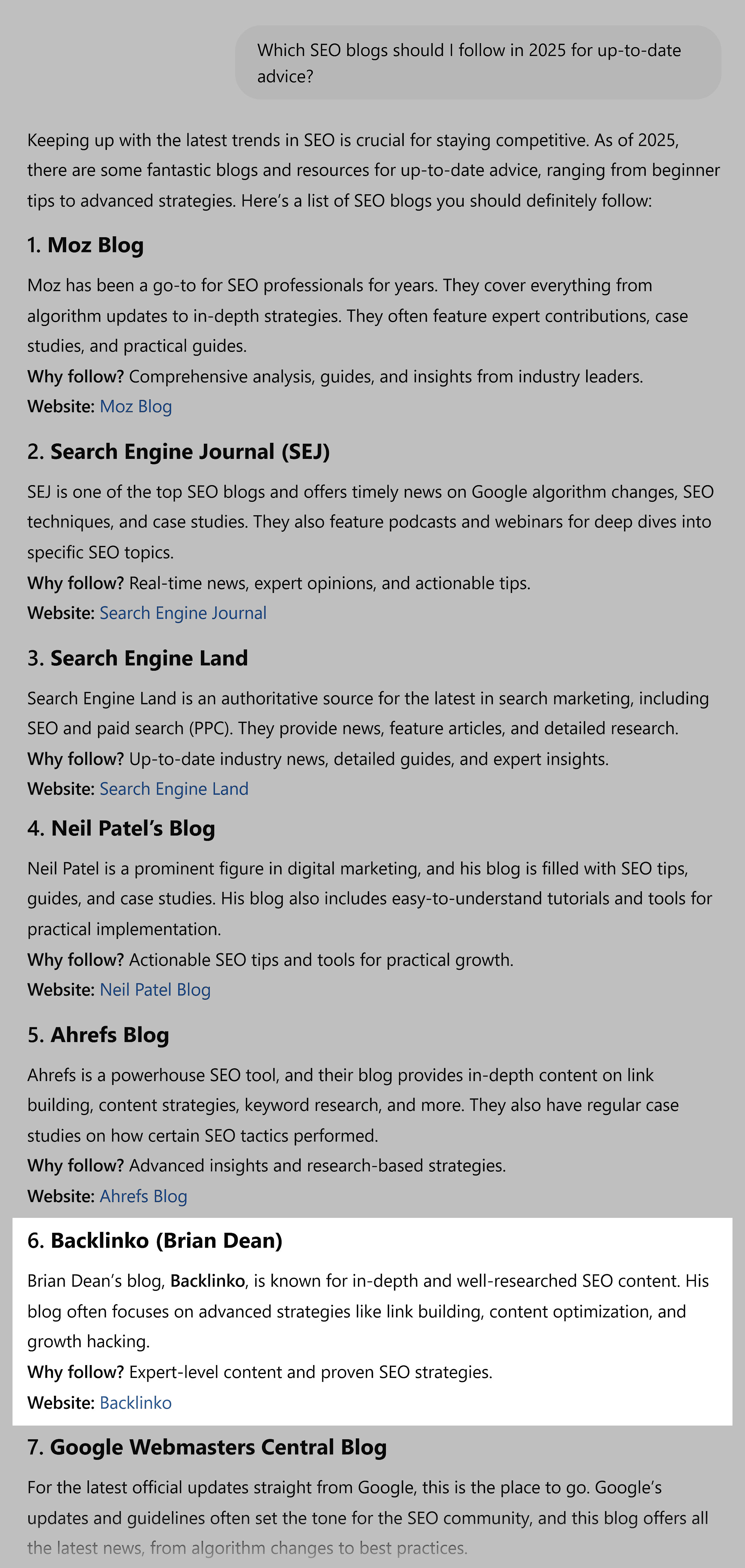
But here’s where it gets interesting.
When I asked ChatGPT the same question, logged in, I got a completely different answer.
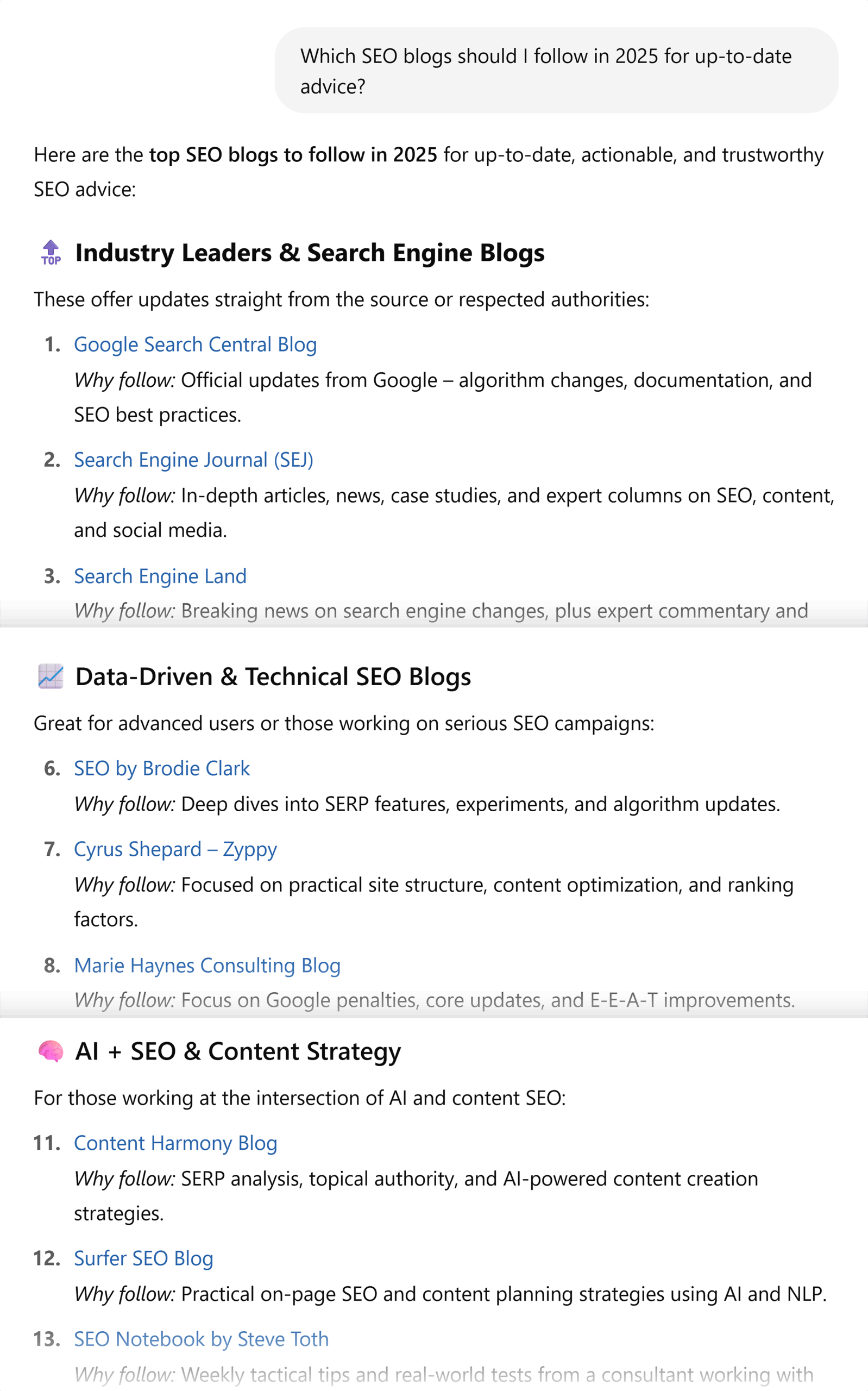
Instead of citing the usual suspects, it focuses on finding diverse, current perspectives across different platforms. It recommends everything from premium newsletters to X/Twitter accounts worth following.
All based on the context of my chat history.
So, Google AI values co-citation patterns, but ChatGPT rewards fresh perspectives and contextual coverage.
This is why your 2023 comparison post might never appear in AI Overviews, but could become ChatGPT’s go-to citation — especially if you’re using AI citation strategies.

What LLMs Actually Prioritize
Early testing suggests that query fan-out and semantic chunk matching are big drivers of LLM behaviour.
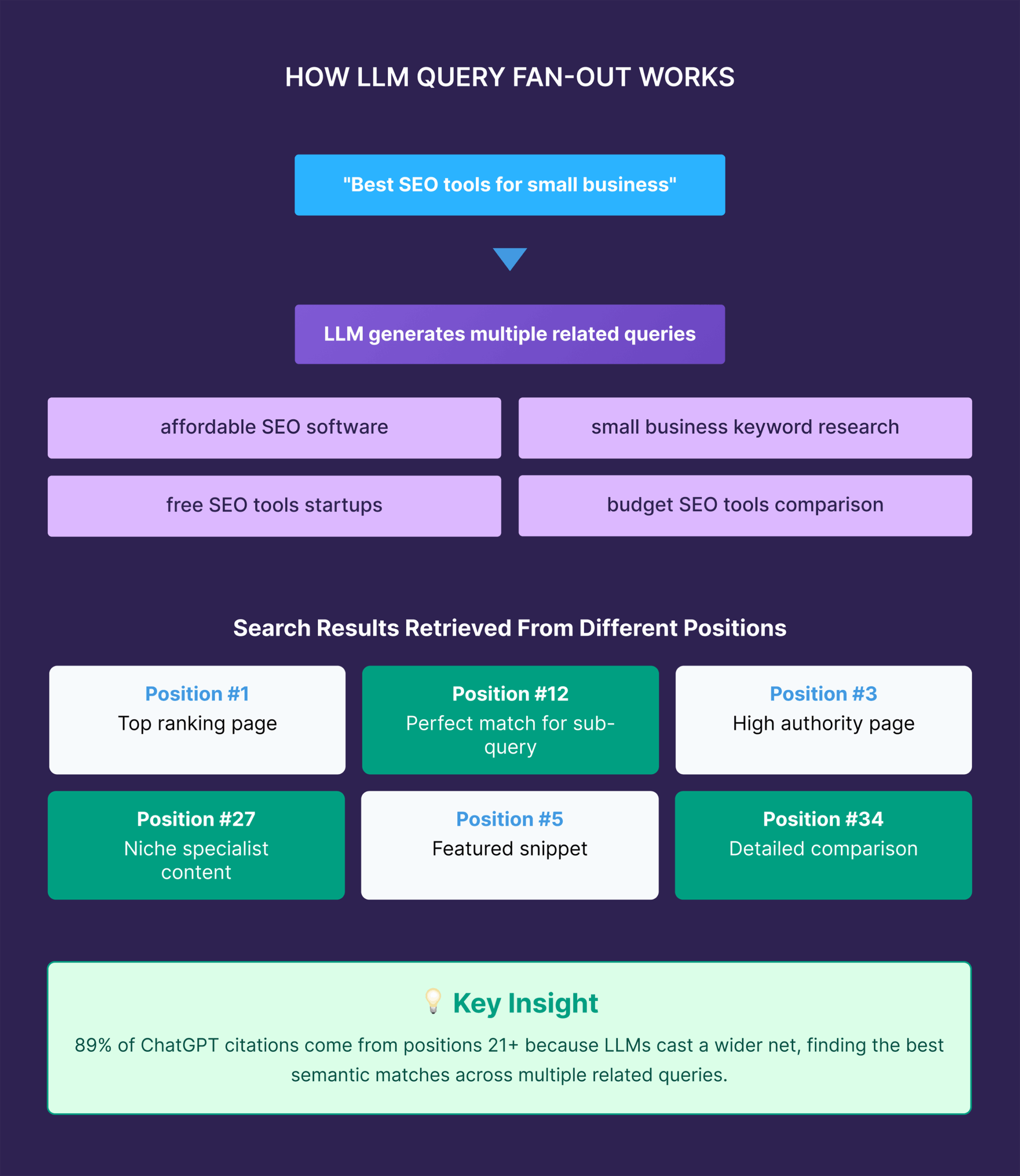
LLMs often create several related sub-queries from your original question, especially for complex topics. They pull the best matches from the web.

LLMs focus on identifying the most relevant content chunks, rather than the highest-ranking pages.
The result?
While strong Google rankings often correlate with LLM citations, the relationship isn’t perfectly linear.
Content ranking lower in traditional search can still get cited by AI systems when it provides the most relevant, specific answer to what users are asking.
To win this transition, continue building comprehensive topical authority. It’s the same principle that has driven SEO success, but now even more critical for LLM visibility.
Further reading: Topic Clusters 101: How to Level Up Your SEO (with Examples)
How LLM Discovery Works in Practice
Here’s what LLM visibility looks like:
Prompt: “How do I build high-quality backlinks to my website?”
ChatGPT Response: Building quality backlinks requires strategic outreach and valuable content creation. The Skyscraper Technique, popularized by Brian Dean from Backlinko, involves finding top-performing content in your niche, creating something better, then reaching out to sites that linked to the original. Other effective methods include guest posting on relevant blogs…
What happens next: The user doesn’t click anywhere. They continue asking about outreach templates and timeline expectations, then later search “Backlinko Skyscraper Technique” or navigate directly to backlinko.com.
The invisibility factor: Branding just influenced a purchase decision, but you’ll never see it in referral traffic.
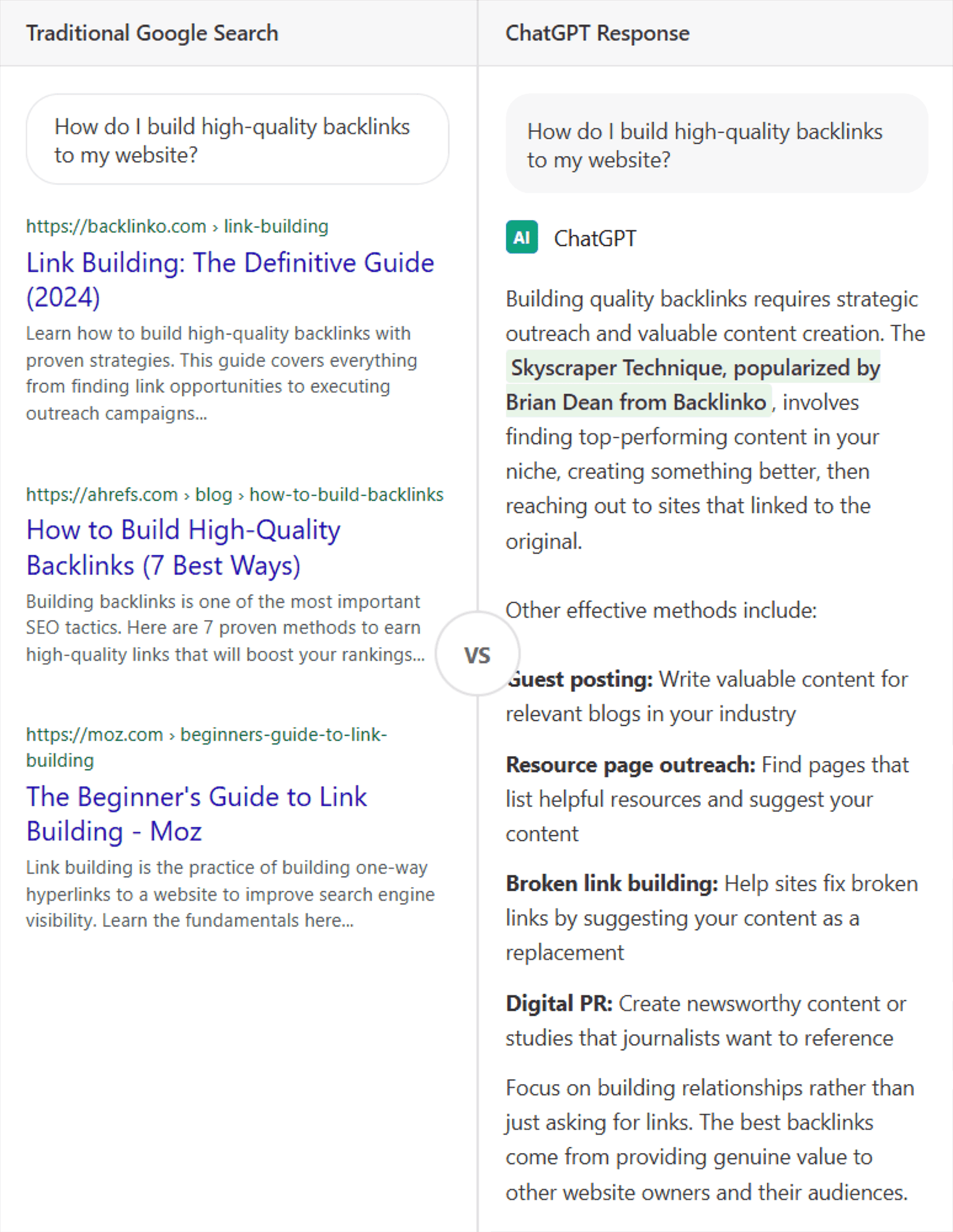
LLMs present information with or without links. Both drive discovery.
Here’s an example of a Perplexity response with a link:
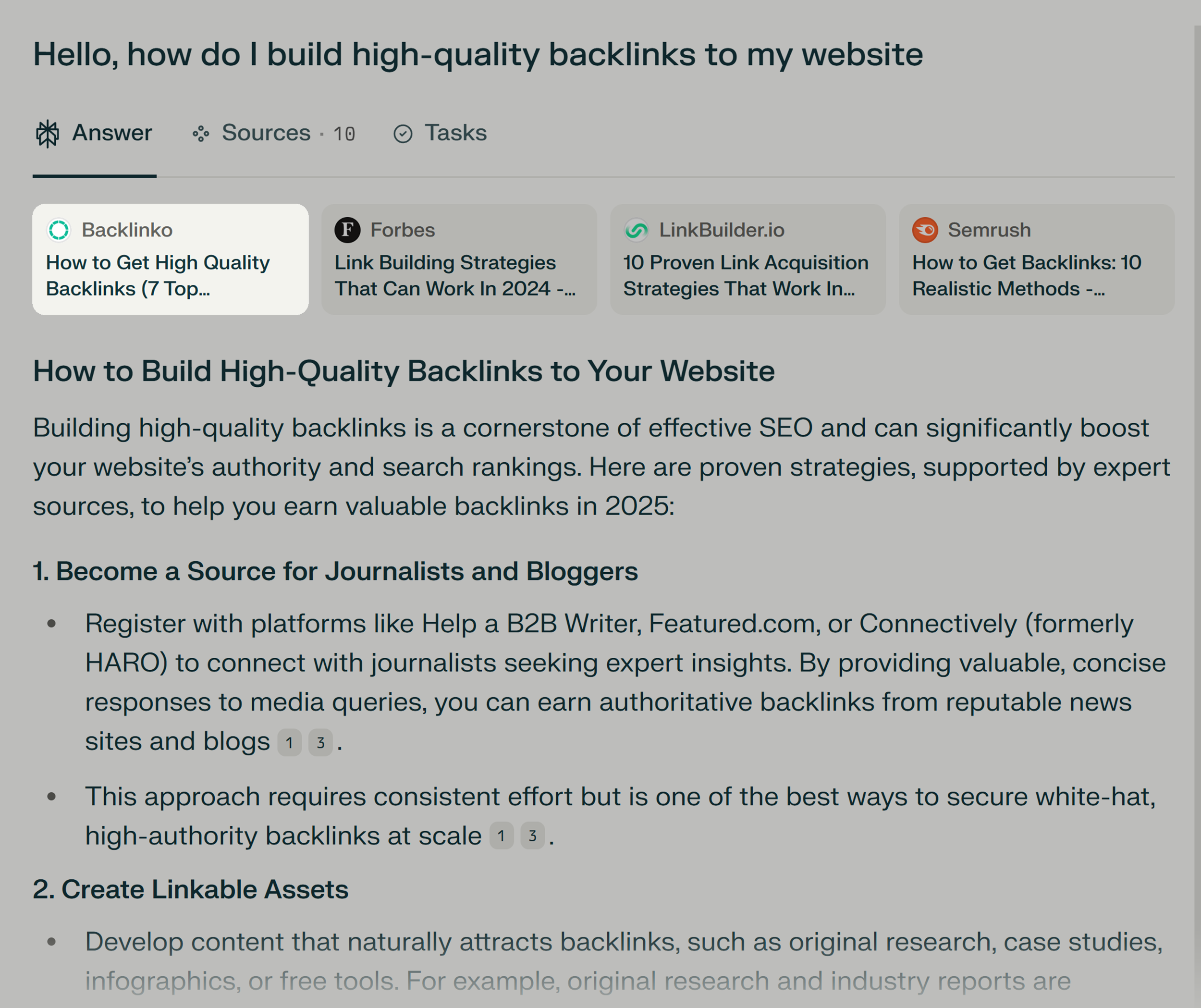
Trends show that citations without links often feel more trustworthy because users don’t sense they’re being “sold to.”
Note: In these examples, we’re referring to RAG (Retrieval-Augmented Generation). It’s where the model often conducts additional web searches (query fan-out, etc.) for complex queries.
Why Your Analytics Are Blind to LLM Growth (And How to Fix It)
Your current measurement tools can’t see the biggest growth opportunity in search, but there are ways to track what actually matters.
What Your Dashboard Misses
When someone discovers you through an LLM and visits later, it appears as:
- Direct traffic (typed your URL or clicked a link that didn’t pass referrer data)
- Branded search (Googled your name)
- Unknown or untagged referral (bookmarked and returned)
It’s worth repeating, there’s often zero attribution to the LLM mention.
Why Traditional Metrics Fail
Google Analytics and Google Search Console were designed for a click-based world.
Old customer journey: See result → Click → Convert (trackable)
New customer journey: See AI mention → Research brand → Visit directly later (invisible)
It’s a measurement paradox. Your most effective discovery channel is completely hidden.
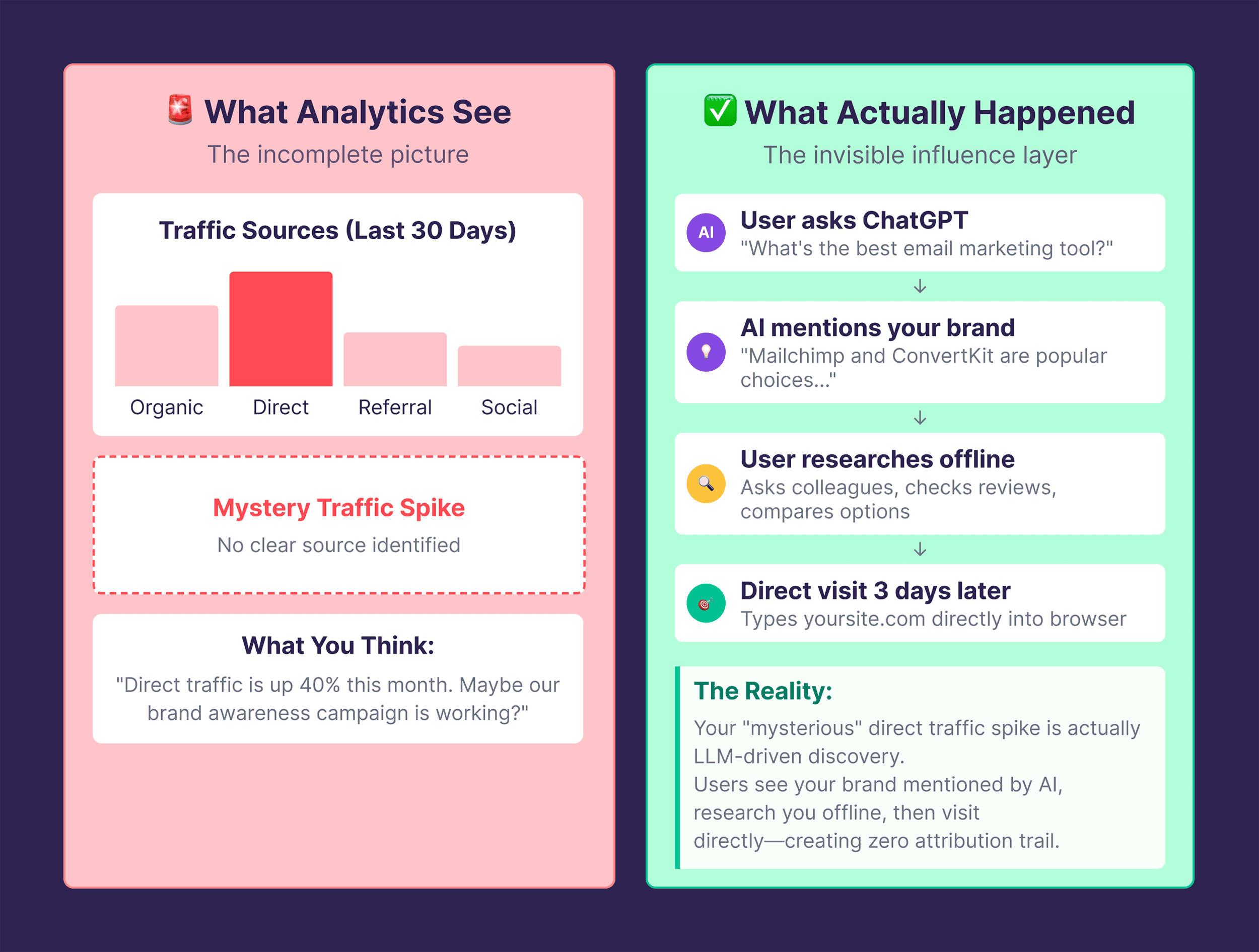
Quick rant:
Google isn’t adding access to traffic data for AI Mode or AI Overviews.
I believe it’s because it’ll reveal just how little traffic both are actually driving to external websites.
Maybe the tide will turn, and eventually, they’ll add the data to their tools. Time will tell.
How to Track Your LLM Visibility
It’s worth acknowledging that LLM visibility tools are new and evolving.
One great place to start is this free Brand Visibility Tracker spreadsheet from AirOps. It offers a straightforward calculation that helps you understand your presence across AI-generated answers.
For more in-depth analysis, I’ve been using Semrush’s AI SEO Toolkit as it provides insights into how your brand compares to competitors in LLMs.
For Backlinko, I added four competitors, and here’s what the report looks like for ChatGPT visibility.
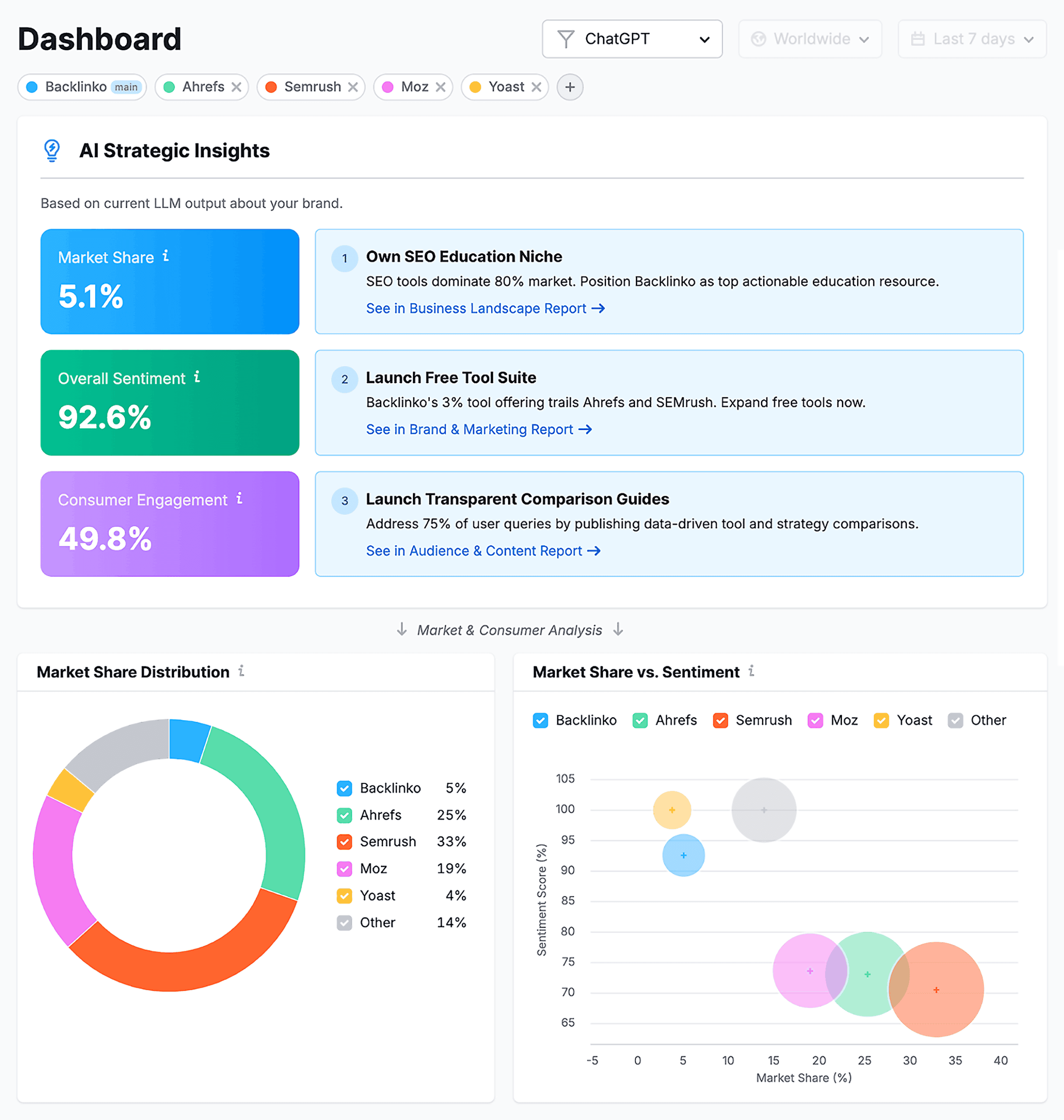
Semrush leads with a 33% market share, followed by Ahrefs at 25%. Unfortunately, we’re sitting at 5%.
Caveat: we’re not a product company, and we have much smaller brand demand than Semrush and Ahrefs.
This matters because LLM visibility may correlate with brand awareness and search volume. Brands with more online discussion and search demand typically have more content and mentions for LLMs to discover and cite.
Yes, how often you’re being mentioned in LLMs is crucial. But how you get mentioned matters just as much.
Back to the Semrush AI SEO Toolkit, Brand & Marketing dashboard shows shifts in sentiment among LLMs.
Backlinko consistently has a high favorable sentiment share.

The Strategic Opportunities section shows where the gaps are and helps you prioritize the execution by timeframe.

So, instead of fighting for the same top rankings, you can build authority in overlooked niches where LLMs need better sources.
Track these metrics monthly:
- Visibility score changes across different LLM models
- Branded search correlation in Google Search Console
- Market share shifts vs competitors
Semrush’s Enterprise AIO offers even more powerful ways to monitor brand visibility in LLMs.
Pro tip: When you see visibility increases, correlate them with branded search spikes in GSC to estimate real business impact.
The Measurement Mindset Shift
Traditional SEO measurement focuses on traffic and tracked conversions.
LLM visibility measurement focuses on influence created.
Instead of asking “How many clicks did we get?” ask “How much authority did we build?”
The businesses that adopt this measurement philosophy first will have a massive advantage in AI-driven search.
Building Authority That AI Actually Recognizes
Here’s the good news:
Building authority for LLM visibility isn’t about throwing out everything you know about SEO.
What makes content trustworthy for people — like clear structure, real expertise, and thorough coverage — also helps AI systems see it as authoritative.
But there are some nuances worth understanding.
Why SEO Authority Still Matters (Mostly)
Again, your existing SEO work isn’t wasted.
LLMs mine the same content ecosystem as search engines, but they have different priorities.
We’re at a critical inflection point where everyone is moving fast and low-quality content is becoming rampant.
Google search used to be messy. I mean, it’s not perfect now, but it’s vastly better than pre-2010.
For LLMs to succeed long-term, they need to maintain and develop ways to promote real authority and trustworthy sources, not just those who cheaply game the system.
The overlap between traditional SEO authority and LLM visibility is significant:
- Content depth and expertise matter to both systems
- Clear information architecture helps both humans and AI navigate your content
- Consistent topic coverage builds authority across platforms
- Original insights and data get cited by both search engines and LLMs
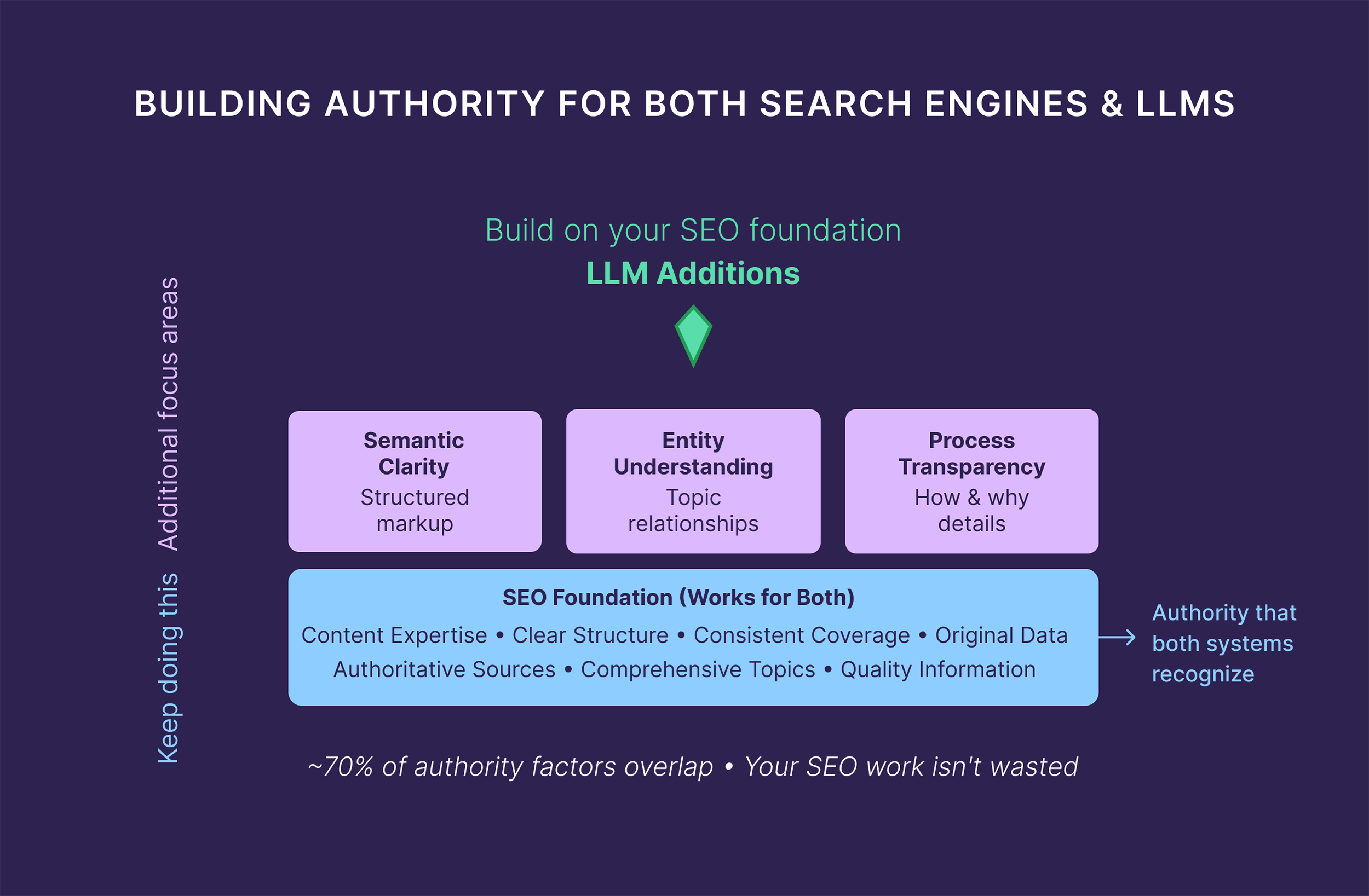
Where things diverge is in the details. And those details create opportunities.
Expertise Depth Over Keyword Coverage
You’ve probably heard SEO advice that creates a false choice between keyword optimization and content quality.
But if you’ve been following sound SEO principles, you already know that keywords are simply demand signals.
They’re data points that help you understand what your audience wants to learn and prioritize your content efforts.
LLMs have made this quality-first approach non-negotiable.
The citation analysis shows that AI systems consistently favor sources that demonstrate genuine expertise. Content that covers edge cases, recognises complexity, and shares insights from real experience.
Surface-level content aggregation used to rank well just by optimizing keywords. Now, it gets fewer mentions in AI responses.
This isn’t because LLMs dislike keywords. It’s because they’re better at recognizing and rewarding authentic expertise.

This means sharing process details, insightful nuances, and clear methods that both people and AI see as trustworthy.
Include the details that only practitioners would know.
Acknowledge when approaches don’t work and explain why.
Be clear and precise in your explanations. This helps both humans and AI systems understand your expertise accurately.
LLMs have simply made the stakes higher for thin content while rewarding the approach that quality-focused practitioners have always advocated.
The Strategic Citation Playbook
If you’ve been building quality backlinks, you’re already 70% of the way to LLM citation success.
The research reveals that citation-worthy content follows similar principles to link-worthy content, with a few critical differences in how citations actually work.
How to Get Cited Alongside Competitors
The research shows a clear pattern among top-cited brands. They consistently appear alongside other authorities in expert clusters.
When industry publications discuss “best practices for X,” they cite multiple experts.
Your goal is to be part of that conversation.
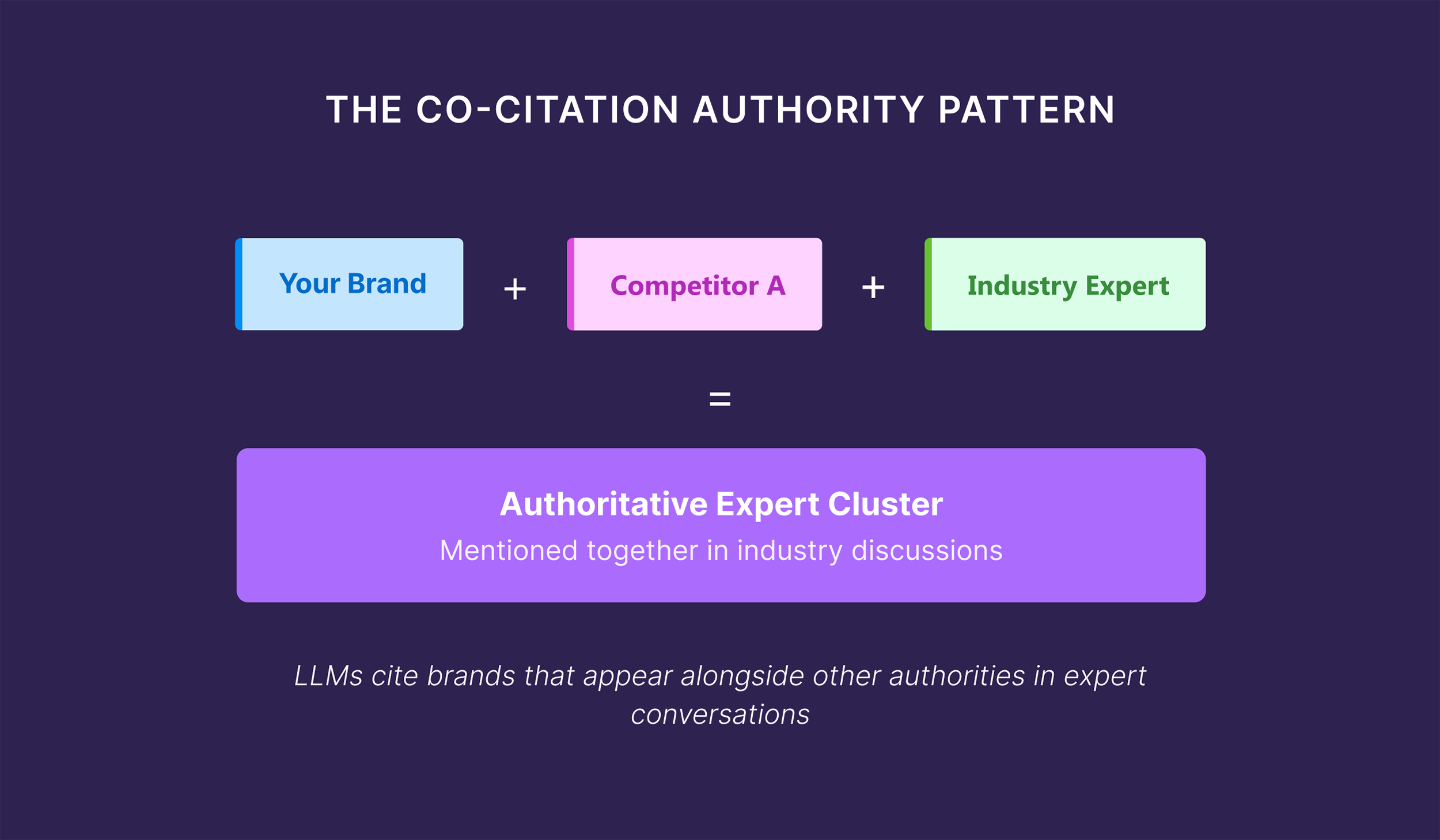
Practical focus:
- Guest post on publications that already cite your competitors
- Participate in expert roundups where your insights add genuine value
- Comment thoughtfully on high-authority industry content with detailed expertise
Citations vs. Links: What’s Different
LLM citation patterns mirror what quality-focused SEOs have always known: authoritative sources carry more weight than weak ones.
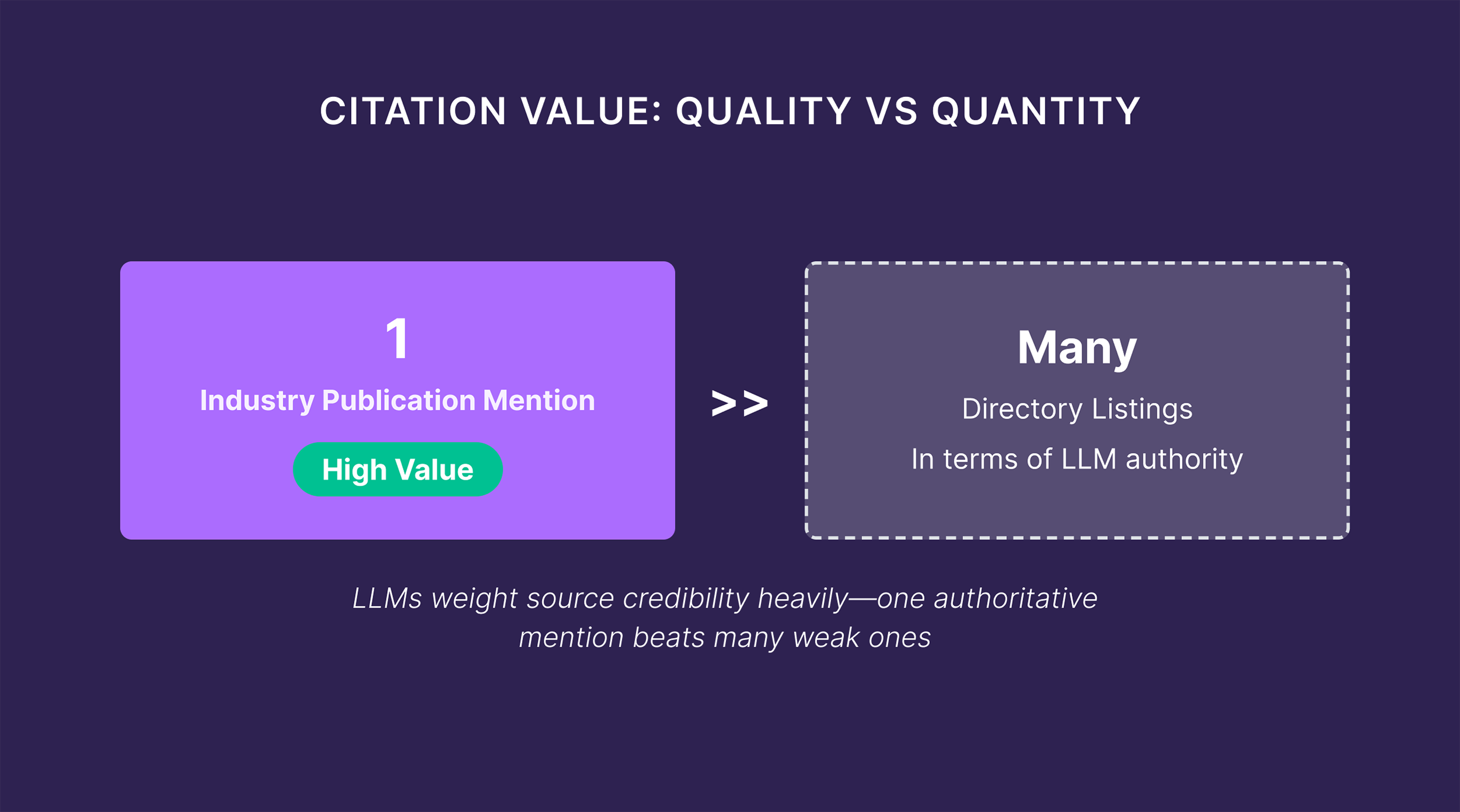
But there are key differences from traditional link building.
- Citations don’t require links: A thoughtful Reddit comment or YouTube video description can carry citation weight without clickable links back to your site.
- Content depth beats ranking position: LLMs evaluate expertise independently of SERP rankings. Your detailed comparison post ranking on page 6 can become your most-cited asset.
To win LLM visibility, strategically place your expertise where AI systems recognize genuine authority.
Why Your Small Brand Can Compete in LLMs
The LLM visibility shift creates the biggest opportunity for smaller brands since the early days of SEO.
While established competitors fight for the same top rankings, you can build authority in the spaces they’re ignoring.
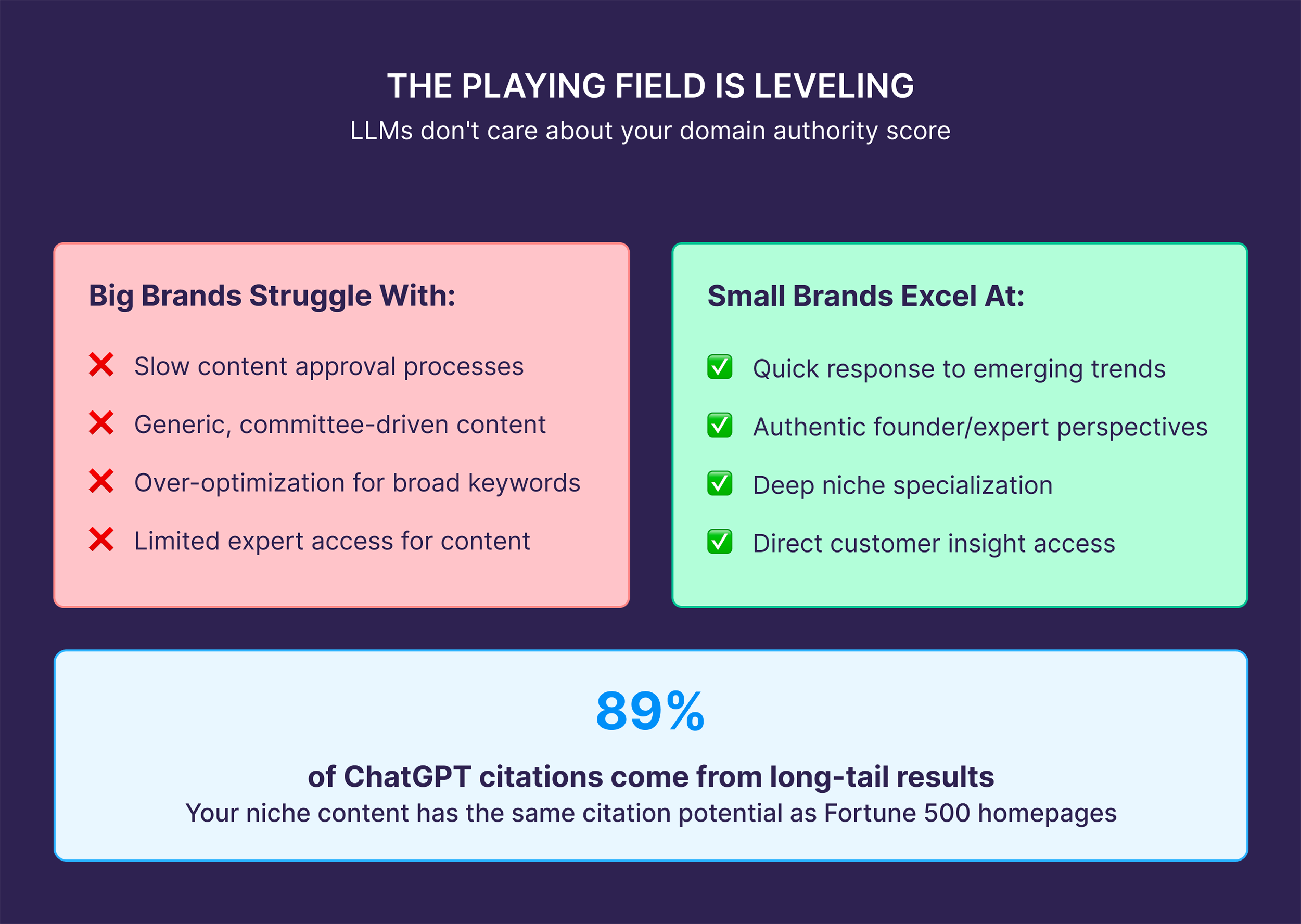
Remember: Almost 90% of ChatGPT citations come from long-tail results.
Your niche expertise on “B2B SaaS customer onboarding analytics” has the same citation potential as a Fortune 500 company’s homepage about “business software.”
Speed Beats Scale
Big brands move slowly. Committee approvals, legal reviews, and corporate messaging requirements create lag time.
You can capitalize on emerging trends, respond to breaking news in your industry, and share real-time insights that LLMs value for currency and relevance.
When a new platform launches or regulations change, you can publish authoritative analysis within hours while competitors are still scheduling meetings.
The Community Multiplier Effect
Your engaged audience amplifies LLM visibility in ways traditional SEO can’t measure.
When customers share your insights in Quora answers or LinkedIn comments, they’re creating citation pathways that LLMs discover and value.
A single detailed Reddit comment from a satisfied customer can carry more LLM authority than a generic press release.
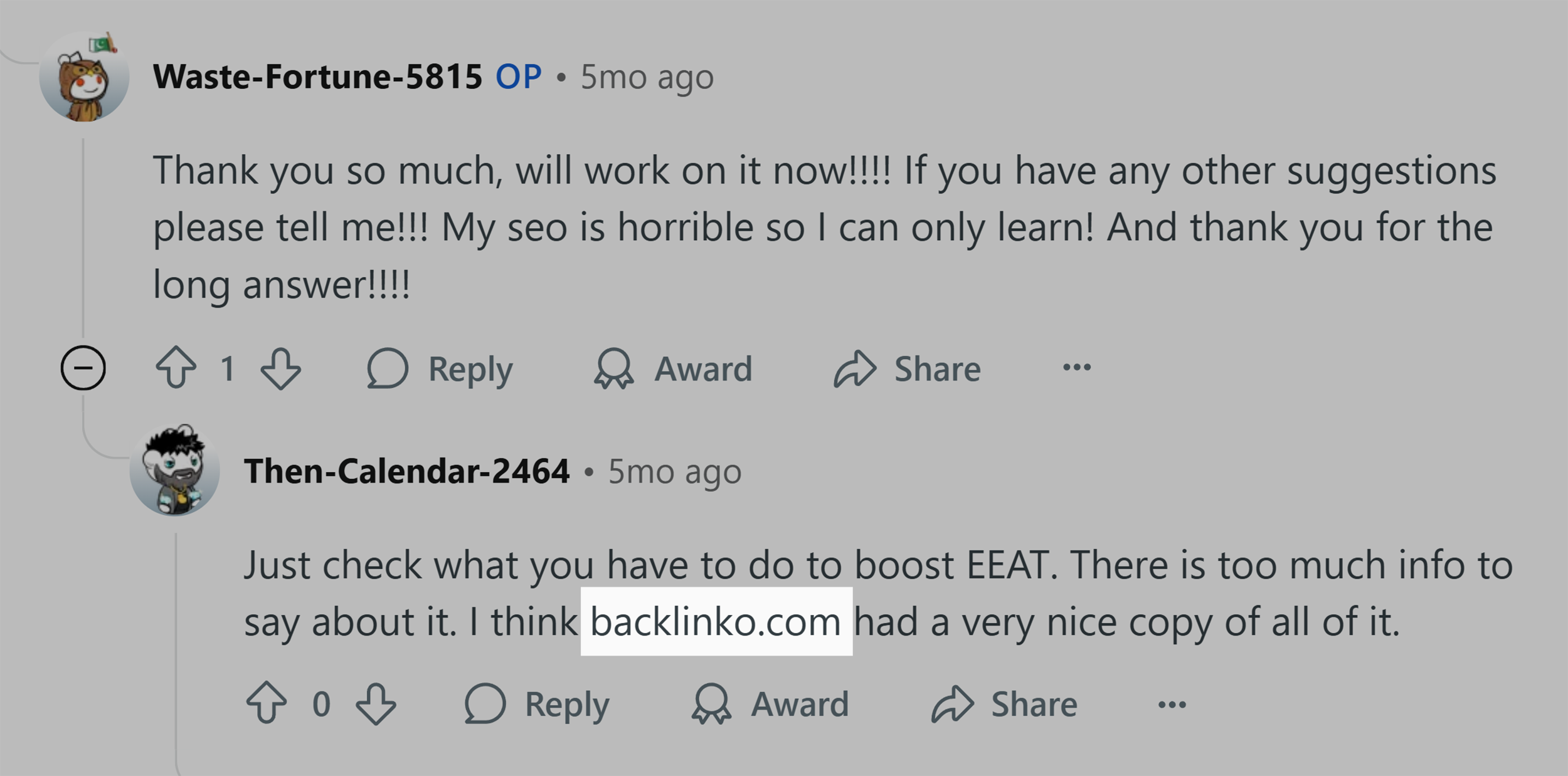
Start Small, Win Big
Pick one sub-topic where you have genuine expertise. Become THE authoritative voice on that specific area.
Instead of competing for “project management software,” own “project management for creative agencies with remote teams.”
Target long-tail prompts where competition is lighter and your specific experience matters most.
Track your progress with tools like Semrush’s AI SEO Toolkit and Enterprise AIO to see your authority build across conversations that matter to your business.
Lastly, be wary of anyone definitively selling you GEO, AI Search Optimization, or whatever term they’re using.
We’re in a fluid and developing environment, but the fundamentals remain key.
Focus on building a brand and think about how to create the right content that will stand up over time.
Avoid shortcuts and quick wins that are risky.
Your move.
Backlinko is owned by Semrush. We’re still obsessed with bringing you world-class SEO insights, backed by hands-on experience. Unless otherwise noted, this content was written by either an employee or paid contractor of Semrush Inc.






